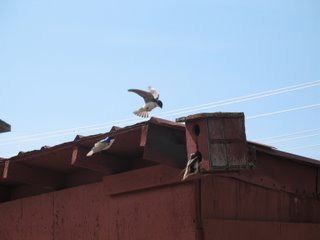Full Blown Spring

In the usual rapid progression of the season that southwest Alaska can experience in late May, we’ve gone from a white-out blizzard two weeks ago to nearly summer. The weather continues to be outstanding, bright clear skies and warm sun—65 degrees today!—and warm steady winds. The tundra is drying out rapidly. Most of the birds have established their nesting spots and are settling down to that serious business of hatching a brood. The swallows are still having a few turf wars, as the photo shows. Soon the mosquitoes will be with us, and the experience of the outdoors will change a lot.
The tundra is like a huge grassy sponge, with permafrost underlying it at depths that vary from inches to feet. What’s on top of the permafrost melts in the summer, and there is standing water all over—lakes, streams, rivulets, ponds, puddles, and sloughs—surrounding hillocks and knolls of dirt and low shrub cover. You can sink to your ankles in water when walking in low spots on the tundra, even when it seems pretty dry.
What all this wet ground provides is the perfect mosquito breeding habitat. And they do it quite successfully. We jokingly refer to the mosquito as the state bird of Alaska, and that is not too much of an exaggeration. So, yeah, they are big. And right after a hatch, there will be so many of them that they boil up from the long grasses around the watery spots like a cloud. Mosquitoes are capable of actually killing large animals like caribou. The only escape for the animal is to run into a river and submerge to the nostrils. People go around wearing those dorky-looking hats with mosquito curtains, or bug shirts with full hoods and zippered mesh faces.
Dorky or not, they work. Last summer Dutch spent two days weed-wacking the long grasses in the low-lying areas of our yard, often standing for long periods in a buzzing haze of mosquitos. Without the bug shirt, he’d have been eaten alive. Anybody planning a trip to Alaska in the late spring and summer should have one. Cabela’s is a great source for good gear, and their Instant Bug Jacket does a good job of keeping the little peskers off you.
Knowing that the bugs are coming makes this brief interlude we’re having all the more sweet. A few days of warm, sunny weather with NO BUGS—ahhhhhhh. We cherish that. I can’t be outside enough right now. This week the sun is rising about 5:30 am and setting about midnight, giving us over 18 hours of actual shine, but more like 21 hours of light that is adequate to read a newspaper by. So much daylight really charges people, and lots of activity goes on until late in the evening. People are repairing their boats, cleaning their chainsaws for logging, mending their fishnets for the salmon season, airing out their houses from the long winter, and walking around town visiting with each other. The outward expansion of spring is fully upon us.
In only three weeks we will be approaching the summer solstice, the longest day of the year; and then the light will begin receding at the same rate that it is currently growing: five minutes per day. That happens before summer feels really good and started here, as June is often rainy and cool. For most of July and early August, it is a nearly imperceptible recession, and the summer days are long and hot. We’ll have temperatures in the 90s for a week or two, and may even break 100 degrees. And considering that there is no air conditioning in Bethel, that can make for an uncomfortable period, even though it is brief.
Eskimos hate to sweat—it can be life-threatening in the wintertime to do so—and the comment “It’s tooo hottt!” is often heard when the thermometer starts pushing the high 80s. Fortunately, we have a fairly low humidity rate, despite all the surrounding water, so this place is nothing like the oppressive wet heat of the Deep South in summer. The air stays cool, and getting down by the river is a guaranteed relief from the heat. And no matter what, it won’t last long. Summer in the subarctic is packed into a few short weeks. Every form of life seems to know that at the cellular level, so growth happens quickly. Winter is always just around the corner.
Labels: Tundra Life




0 Comments:
Post a Comment
<< Home